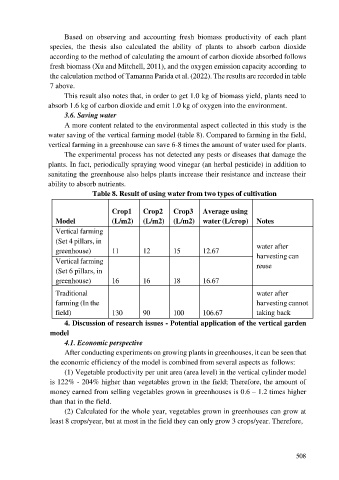Page 516 - Ebook HTKH 2024
P. 516
Based on observing and accounting fresh biomass productivity of each plant
species, the thesis also calculated the ability of plants to absorb carbon dioxide
according to the method of calculating the amount of carbon dioxide absorbed follows
fresh biomass (Xu and Mitchell, 2011), and the oxygen emission capacity according to
the calculation method of Tamanna Parida et al. (2022). The results are recorded in table
7 above.
This result also notes that, in order to get 1.0 kg of biomass yield, plants need to
absorb 1.6 kg of carbon dioxide and emit 1.0 kg of oxygen into the environment.
3.6. Saving water
A more content related to the environmental aspect collected in this study is the
water saving of the vertical farming model (table 8). Compared to farming in the field,
vertical farming in a greenhouse can save 6-8 times the amount of water used for plants.
The experimental process has not detected any pests or diseases that damage the
plants. In fact, periodically spraying wood vinegar (an herbal pesticide) in addition to
sanitating the greenhouse also helps plants increase their resistance and increase their
ability to absorb nutrients.
Table 8. Result of using water from two types of cultivation
Crop1 Crop2 Crop3 Average using
Model (L/m2) (L/m2) (L/m2) water (L/crop) Notes
Vertical farming
(Set 4 pillars, in water after
greenhouse) 11 12 15 12.67
harvesting can
Vertical farming reuse
(Set 6 pillars, in
greenhouse) 16 16 18 16.67
Traditional water after
farming (In the harvesting cannot
field) 130 90 100 106.67 taking back
4. Discussion of research issues - Potential application of the vertical garden
model
4.1. Economic perspective
After conducting experiments on growing plants in greenhouses, it can be seen that
the economic efficiency of the model is combined from several aspects as follows:
(1) Vegetable productivity per unit area (area level) in the vertical cylinder model
is 122% - 204% higher than vegetables grown in the field; Therefore, the amount of
money earned from selling vegetables grown in greenhouses is 0.6 – 1.2 times higher
than that in the field.
(2) Calculated for the whole year, vegetables grown in greenhouses can grow at
least 8 crops/year, but at most in the field they can only grow 3 crops/year. Therefore,
508

